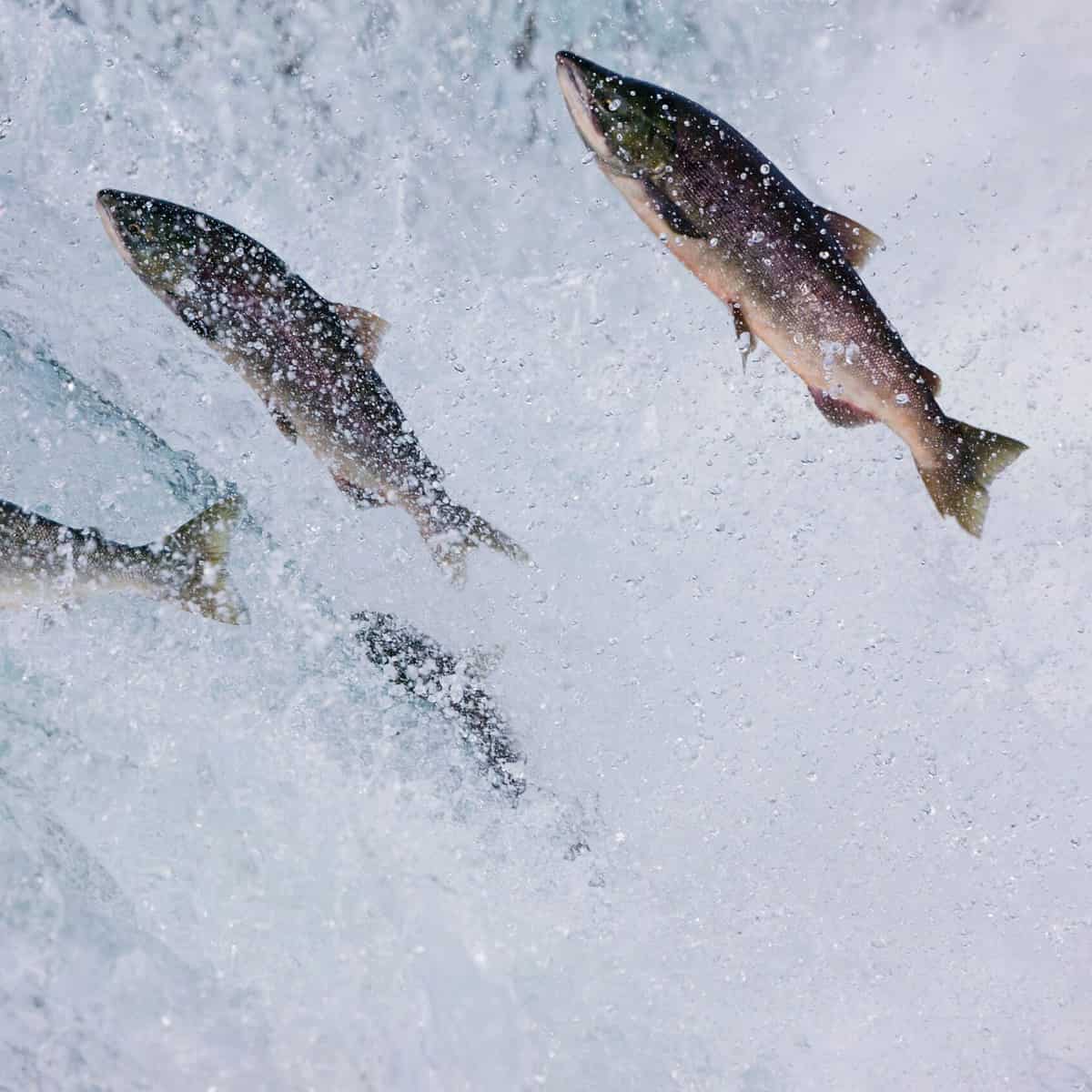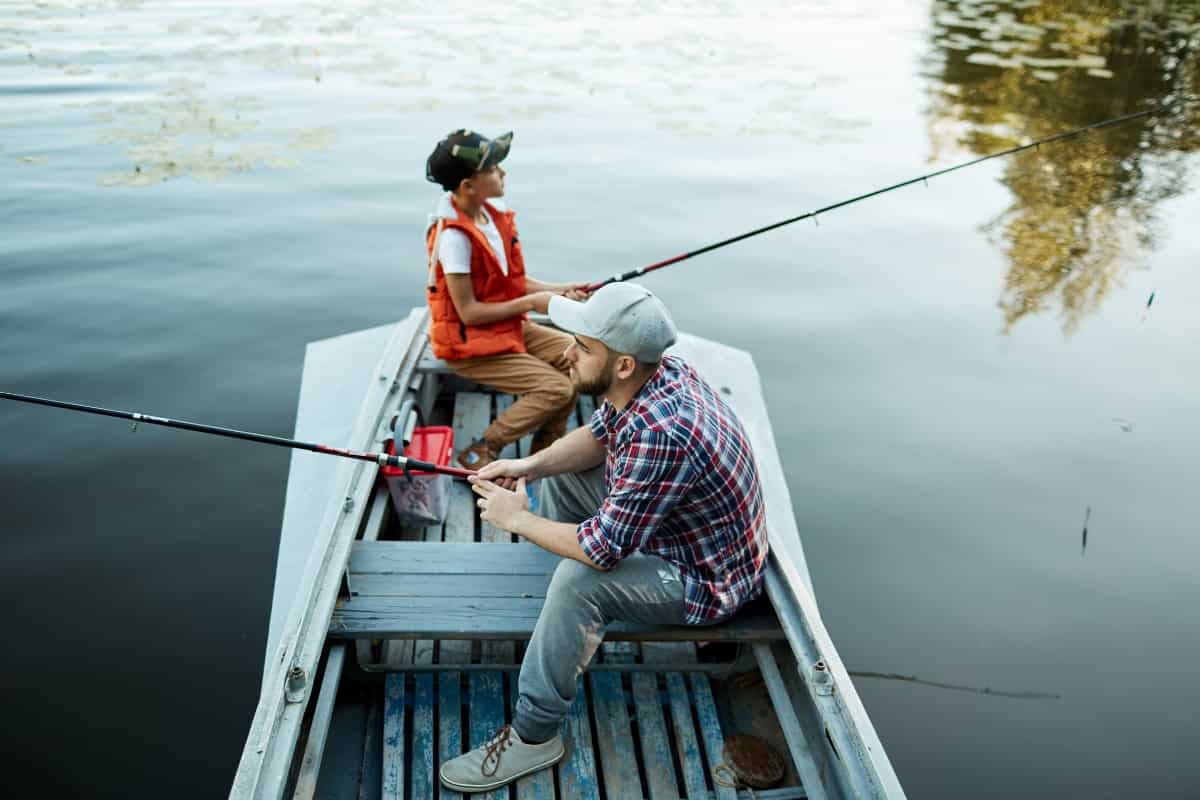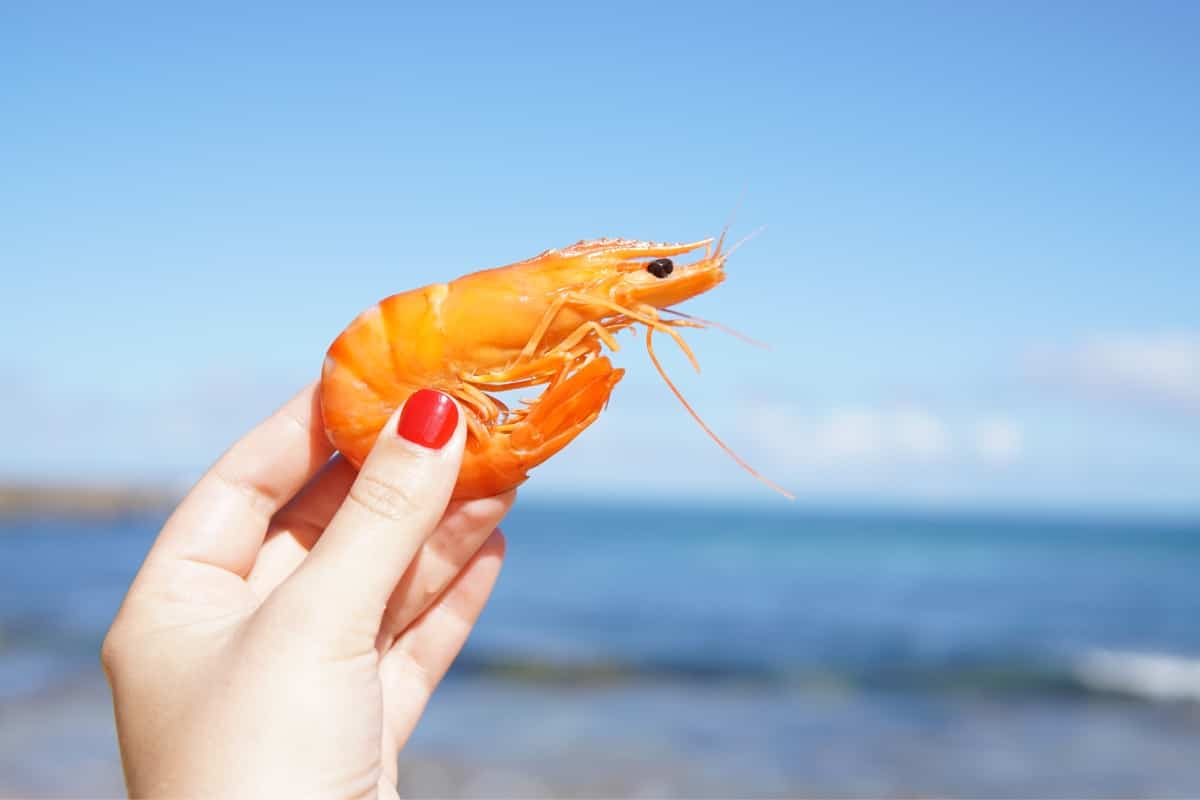What comes to mind when you hear the words trout fishing?
For most anglers and outdoorsmen it’s flowing streams with clear cool water and a peaceful quiet atmosphere.
This pretty much sums up trout fishing.
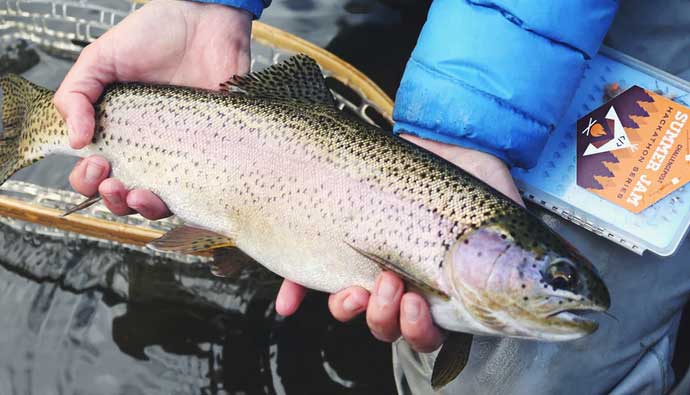
In this article, we’re sharing some tips that will help you catch a wide variety of trout species.
Listen to the Cast & Spear Podcast
Subscribe to the Cast & Spear Podcast on iTunes
Understanding Trout Species
Trout are targeted by many anglers, especially the fly fisherman.
They are simple fish who need three basic things:
- Plenty of food
- Clean flowing water
- Shelter from predators
The different species of trout all have their special quirks. From where they like to hang in the river, what they like to eat, what time of the day they’re active, and the technique you need to catch one.
That’s what makes trout fishing so enjoyable. The chess match with the fish.
Trout have fins entirely without spines and all of them have a small adipose fin along the back near their tail. The pelvic fins sit well back on the body, on each side of the anus.
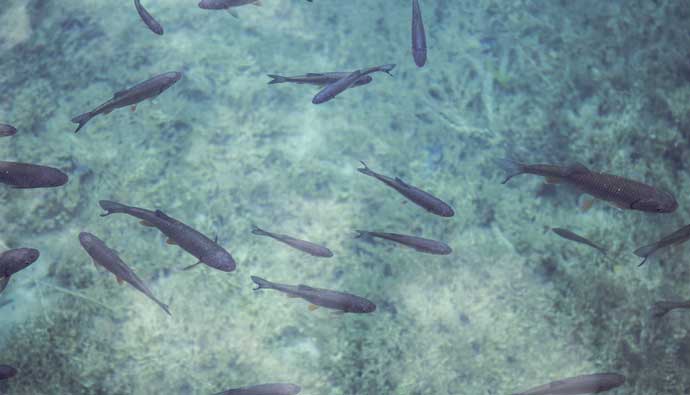
The swim bladder is connected to the esophagus, allowing for gulping or rapid expulsion of air, a condition known as physostome. Unlike many other physostome fish, trout do not use their bladder as an auxiliary device for oxygen uptake. They rely solely on their gills for oxygen.
Different Types of Trout
- Below we’ve specified their favorite locations depending on the trout type. However, if the water conditions change, these areas where you typically find a certain trout will be different.
- For example, when the water runs high, trout like to move to banks and away from fast-moving water to pick on worms and other insects that fall into the water.
- If the water is murky, they will likely reside by a structure, such as a boulder, to help keep their equilibrium in check.
- When water gets warm, they will migrate to a cooler area of the river or lake.
- Early in a trout’s life, they feed on plankton, diatoms, and algae. When they reach a certain size they switch to insects to help fuel their growth.
- Some trout like the Tiger Trout are hybrids of two different trout species.
- When trout reach sizes of sixteen or more inches they need even large insects and sometimes even mammals like mice and birds like ducklings.
Types of Trout
Rainbow Trout
Rainbow Trout Facts
- Scientific Name: Oncorhynchus mykiss
- Identifying Characteristics: They have small and irregular black spots on the back and on most fins. Look for the pink stripe on the side (this won’t be on sea-run trout). Also, look for the black spots on the caudal fin.
- Locations for How to Catch: They like clear, cold headwaters, creeks, and small to large rivers. You can also find them in lakes and intertidal areas. Rainbow trout live in the fastest currents along the river.
- Size: Rainbow trout have been seen up to 27 pounds.
Rainbow Trout Fishing Tips
Rainbow trout are similar to mahi-mahi in that they take to the sky once hooked. It’s not uncommon to see one leap into the air while attached to your line. Many fly fishermen love catching this trout because they put up one of the greatest fights outside of the ocean. Plus, they’re one of the best tasting freshwater fish today. They are also an accessible trout which means you’ll be catching them in easier-to-reach areas along the river such as pools, pockets, and riffles.
Coastal Rainbow Trout / Steelhead
Coastal Rainbow Trout Facts
- Scientific Name: Oncorhynchus mykiss irideus
- Identifying Characteristics: Look for the bright red-pink stripe along the side which is most notable on spawning males. They will also be covered in black spots on their head, body, and fins.
- Locations for How to Catch: Steelhead is found along the coast from Alaska all the way down to Southern California. They like clear, cold headwaters, creeks, and can be found in small and large rivers, lakes, and intertidal areas. They are anadromous in coastal streams.
- Size: They can reach 27 pounds.
Eagle Lake Rainbow Trout
Eagle Lake Rainbow Trout Facts
- Scientific Name: Oncorhynchus mykiss aquilarum
- Identifying Characteristics: They have a lot of black spots that are irregularly shaped on the pink side of their dorsal and caudal fins.
- Locations for How to Catch: These are a rare breed of rainbow trout to find and are mainly in the northeastern part of California. However, you can find them in some lakes and reservoirs of other western states if stocked by this species. You’ll find the natives in the open water of Eagle Lake.
Kern River Rainbow Trout
Kern River Rainbow Trout Facts
- Scientific Name: Oncorhynchus mykiss gilberti
- Identifying Characteristics: They look similar to the Sacramento Rainbow Trout, so look for the purple parr marks on them and a duller less intense red stripe along the side.
- Locations for How to Catch: You’ll find them at higher elevations in small, cool creeks and lakes.
Brown Trout
Brown Trout Facts
- Scientific Name: Salmo trutta
- Identifying Characteristics: Look for the red and black spots on the head and body with large black spots on the gill cover. They tend not to have black spots on the caudal fin and no white edge on the anal fins or on the pelvis.
- Locations for How to Catch: Small brown trout like slow-moving water. Large brown trout like very slow-moving water around cut banks or around boulders that block the flow of water. They do this so they can pounce on unsuspecting baitfish. You’ll find most in cool, high-gradient streams and cold lakes. The adults will live in pools, and the younger ones will be in both pools and riffles.
- Size: The average length of a brown trout is 40–80 cm(16–31 in). The maximum length is 140 cm (55 in) and about 60 pounds (27 kg).
Brown Trout Fishing Tips
Brown trout are one of the smarter species of trout. So smart in fact that large ones are known to learn from the past…try getting the same thing past them twice!
These trout like to hang in deeper pools, rock cliffs, boulders, banks, brush, undercuts, and overhanging banks.
The best time to fish these trout are dusk and near dark when they leave the hideouts and venture to eat. During this time, they are looking for smaller fish to eat. If you’re fishing for them during the day, know that they tend to be selective in their bites. If you’re fly fishing, the dry fly must be presented perfectly…otherwise, good luck!
Brook Trout
Brook Trout Facts
- Scientific Name: Salvelinus fontinalis
- Identifying Characteristics: Their caudal fins are slightly bent to near straight. Their backs are a nice dark green color that gradients down to a yellow and orange belly. They have a light green or cream-yellow wavy lines/blotches on their backs and dorsal fin that break into smaller spots on their sides. If it’s anadromous, then look for their dark green tops with pale pink spots on the silver side. When males breed, they turn bright orange or red with a black belly.
- Locations for How to Catch: They like the pools at the inner bends of streams. Look for them in clear, cool, and well-oxygenated creeks, small to medium-sized rivers, and lakes.
Brook Trout Fishing Tips
Brook trout are found in higher elevations across the northern part of California and being introduced in many places across the globe. They like very cold water.
They are not the smartest trout in the bunch, but they’ll put up a good fight for you. Many anglers say they can be fooled easily and tend to feed lower in the water column making fly fishing a bit more challenging.
They are easily reached in most rivers and streams but are found in most waterways.
Lake Trout
Lake Trout Facts
- Scientific Name: Salvelinus namaycush
- Identifying Characteristics: Lake trout have a deeply forked tail fin. You’ll find many wavy-looking spots across its green-back that are cream or yellow in color. These spots cover most of the trout. They have similar coloring to Brook trout without the orange or red underbelly.
- Locations for How to Catch: They like the cruise the edge banks during late fall or right after ice-out. All the other times you can find them at the bottom of the lakes.
Lake trout are found in many of the larger lakes in North America. How long do trout live? They live much longer than rainbow trout, which have an average maximum lifespan of 7 years.
Lake trout can live for many decades and can grow to more than sixty-six pounds.
Trout generally feed on other fish and soft-bodied aquatic invertebrates.
These also include
- flies
- mayflies
- caddisflies
- stoneflies
- mollusks
- dragonflies.
This makes trout a fly fisherman’s dream.
Adult trout will eat smaller fish up to 1/3 their length. Trout may feed on shrimp, mealworms, bloodworms, insects, small animal parts, and eel. For this reason, these make very good trout baits.
Golden Trout (California Golden Trout)
Golden Trout Facts
- Scientific Name: Oncorhynchus aguabonita
- Identifying Characteristics: Golden trout have 10 to 12 dark purple parr marks on their sides. They have a copper top and a red stripe along their golden-yellow sides. Look for the bright red belly and cheeks. They are unique-looking trout and hard to miss.
- Locations for How to Catch: These trout are found in the high sierras and other parts of the Upper Kern River system. They are quite common in these areas’ lakes and streams, have been introduced in other waterways, and tend to hybridize with rainbows.
Golden Trout Fishing Tips
Some anglers believe these are the most beautiful trout. They come in various shades of red, yellow, blue, lavender, and pink hues. You’ll only find them above 10,000 feet, so dust off those hiking boots. They are in California, Alberta, Montana, and Wyoming. They are picky eaters so bring your A-game. They like to feed on chironomids (midges), which means enticing them with flies and other tackle is a challenge.
Little Kern Golden Trout
Little Kern Golden Trout Facts
- Scientific Name: Oncorhynchus mykiss whitei
- Identifying Characteristics: These trout look between a regular Golden Trout and a coastal rainbow trout. They look similar to Golden Trout but have more black spots from the head to their tail. They are also referred to as a golden trout complex.
- Locations for How to Catch: These trout tend to occupy a 100-mile stretch of the Little Kern River and tributaries above the natural waterfall barrier that separates the main stem of the Kern River.
Cutthroat Trout
- Scientific Name: Oncorhynchus clarkii
- Identifying Characteristics: Cutthroat trout are known for the red mark under their jaw that makes it look like their throat’s been slashed with a knife. You shouldn’t see a red stripe on the side, but some populations have a faint or narrow one. Depending on the location, they will vary greatly in color.
- Locations for How to Catch: They are widespread from northern California to Alaska along the coast and east into states like Montana and Colorado. They like gravel-bottom creeks and small rivers and lakes.
Cutthroat Trout Fishing Tips
Cutthroat trout like quiet eddies behind snags. They are similar in demeanor to brook trout and can usually be found in quiet current tongues along undercut banks, under rock ledges, and deadfalls. If you see a slow-moving deep pool, check there too.
They are easy to fool and like the big bushy fly. Throw on some added tinsel, and you’re in business. During the morning, they can be harder to entice to bite, but when you do, they’ll put up a fight.
They need cold water, and it usually takes a bit of effort to get to them, but when you do, you’re in heaven.
Lahontan Cutthroat Trout
- Scientific Name: Oncorhynchus clarkii henshawi
- Identifying Characteristics: They have many black spots on their head and between 21 to 28 rakers on their first-gill arch. The lake form has muted coloring with a light green top and a dull pink side, and a darker pink edge on its gill plate. The stream version has very dark black spots and looks similar to a golden trout but with a liter pink faded stripe and tall parr marks.
- Locations for How to Catch: The historic range for these trout is Lake Tahoe and the Carson, Truckee, and Walker River basins. You’ll find them in the Sierra Nevada Mountains and in Oregon and Nevada.
Coastal Cutthroat Trout
- Scientific Name: Oncorhynchus clarkii clarkii
- Identifying Characteristics: They are covered in black spots, and if they are sea-run, they will have a more elongated head and silvery body and dull orange hue on the sides.
- Locations for How to Catch: They can be found along the coast of Northern California all the way up to Alaska. This is the only sea-run species of cutthroat, and they can be found in many coastal streams, ponds, and lakes.
Bull Trout
- Scientific Name: Salvelinus confluentus
- Identifying Characteristics: Bull trout are similar to the Dolly Varden but with a flatter and longer head. They have a slightly darker back compared to the sides, with a greenish-grey tone and a bunch of yellow-cream spots all the way down to the belly. Their belly can be lighter, but I’ve seen some large ones with relatively the same color belly as the sides.
- Locations for How to Catch: The are found in the Arctic Pacific and tend to be north of Oregon, up through British Columbia, and east of Alaska. They like the deepest pools and snow and glacial runoff.
Habitat
Trout can be found in almost all the larger lakes and rivers. Smaller streams and tributaries are also home to several species of trout.
Trout are more likely to be found and more active in these bodies of water when temperatures stay around 50-60 degrees Fahrenheit.
Since trout feed on small bugs and other larvae, it is not rare to find them close to banks and in very shallow water.
Trout Fishing Gear
When thinking about trout fishing, the right trout gear immediately comes to most anglers’ minds.
The truth is trout can be caught on any standard reel and rod.
Fly Gear
If you are not experienced in fly fishing, or it is just not your style, you can still have a successful trout fishing trip.
The recommended size test line for trout is:
- Weight: 4/5/6
- Taper: WF or DT.
This is common for native trout found in lakes and streams.
Hook Sizes
The best hook size for trout fishing is a 10-12. Remember, the rule of smaller is better does apply. If you are in an area with smaller trout they will not be able to strike larger hooks.
Many experienced trout fishermen say to use red hooks for trout. Make sure your hooks are sharp.
Trout have very sensitive eyes and mouths. If they suspect something is afoot with the bait, they will spit it out before you get a hook set.
A good rule of thumb with hook size. Make sure your hook size is a close match with the size of the bait you are using.
Spinning Reels
When using a spinning or conventional reel for trout, a few things to keep in mind are:
- Line capacity, at least 100 yards – 4-8 pound test monofilament.
- Auto-reverse.
- Metal or carbon fiber parts for corrosion resistance.
- Smooth drag.
- When choosing a rod, 5 ½ to 7 ½ feet work well. Make sure the rod you are using has good sensitivity. An ultra-light model works great.
Recommended Lures
In-Line Spinners
These lures do not look like much, but they can get the job done. Trout have very good eyesight and would not strike this lure on sight alone. But the flash and vibration the spinner makes draw them in out of curiosity.
When reeling the in-line, make sure not to reel too fast. You can actually reel by a trout faster than they can come in for a strike.
Spinner options include standard undressed trebles and single hooks. Also, various types of hair and reflective hackle.
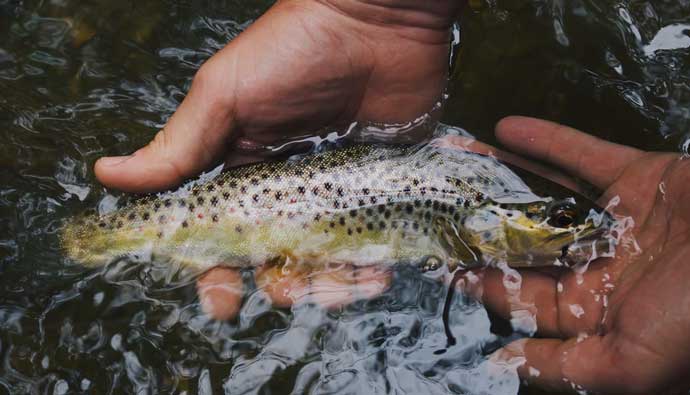
Stickbaits
These minnow-looking lures will draw the attention of just about any trout.
The stick bait can be finessed in many different ways to suit the conditions. They can be reeled fast or slowed down easily.
Stickbaits come as one piece or jointed to produce the most lifelike appearance.3-5 inch stick baits are the recommended size for trout.
Rebel Crickhopper
A steady, medium retrieve is often best in both streams and tailwaters. The crickhopper is very effective when fished slowly.
This bait has a wide wobble and cricket/grasshopper profile for much of the appeal.
Jig and Soft Baits
A leaded hook with artificial soft bait is a sure-fire trout lure. This is often one of the most overlooked yet productive lures in trout fishing.
When trout move offshore in the heat of summer, the leaded jig can easily get down to the depths the trout are at.
Spoons
The spoon is, without a doubt, the go-to lure for trout. Spoons produce wobble and flash that tempts trout when cast, trolled, and vertically jigged.
Spoons come in all shapes and sizes. Choosing the right spoon for the moment often starts with depth control and fall rate considerations.
Light and narrow designs that are thin and light for their length work well for casting and trolling in shallow water. Also, when you are vertical jigging and trout prefer a slow, fluttery fall.
Trout Dough Bait
Last but not least is the dough bait. Also known as Powerbait, this bait has been known to attract fish that were otherwise deemed uncatchable. It is simple to use and produces great results.
A little ball of dough bait applied to a hook or a lure can make a big difference in the effectiveness of the lure.
Tailored Tackle offers all the lures you need to get you going on your next big trout fishing adventure.
Fishing Techniques
Trout fishing is rated as the 4th most popular fishing in North America, behind bass, panfish, and catfish.
Rainbow trout and brown trout are often found in rivers and streams (so choose the right trout lures for rivers if you’re fishing for these). Lake trout and steelhead are more likely to be found in the deep water of many lakes.
Trout need more oxygen-rich water than average fish. For this reason, trout are more likely to be found in flowing water and deep pools created by moving water.
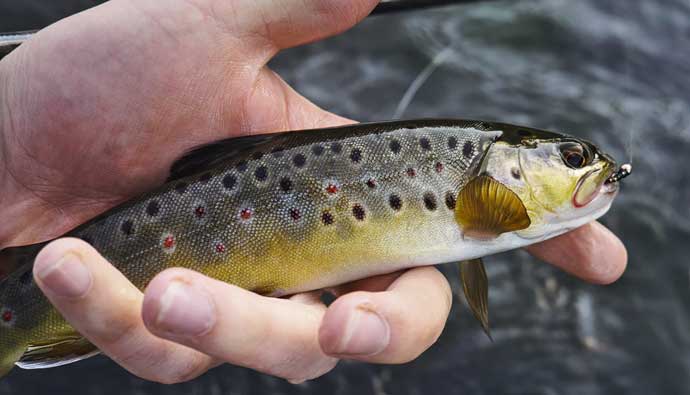
This is why it is important to cast upstream. This will make your bait look more natural to the trout. Trout will also hide behind cover and lay in wait for prey to pass by.
This method of hunting keeps them out of the strong current and conserves energy. Although the current is not as strong behind boulders and cover, this keeps them in oxygen-rich water.
Lake Trout Fishing
When trout fishing in lakes, as the water warms up in spring and summer, the trout will move out to deeper water in search of cooler temperatures
Lake trout tend to stay together in lakes where they are present. That means that if an angler catches one in an area, the odds are good that there are more in that same area.
Unlike bass fishing, where an angler may change location after catching a fish, this is usually not necessary with trout.
How to Release Without Harm
Taking care of a trout or any fish, you plan to release after the catch is extremely important.
Since trout require a lot of oxygen, they need to be released back into the water as quickly as possible.
All fish, including trout, have a special coat of slime on them. This slime protects them from disease and bacteria that may be in the water. For that reason, it is important to handle fish as little as possible. This slime coat can be removed by handling the fish.
If the Trout is Struggling
If a fish is struggling after you release it, it may have used up most of its oxygen content. This is when you will need to give the fish a helping hand.
This is done by gently holding the fish by the stomach, helping it to stay upright. Hold the fish completely underwater and gently move it back and forth slightly. When it is ready,
The most important technique on how to catch trout is to keep it simple and enjoy the time on the water. If you happen to bring home dinner out of the adventure, that’s just an added bonus.
How to Clean

After you have caught your limit of trout, it is time to clean and prepare them to cook. The following is the simplest method for how to fillet a trout.
- Remove the head of the trout. Filleting should be done when you wish to serve only the finest cut of the fish rather than cooking it whole.
- Cut the first fillet along the top of the backbone.
- Flip the trout over and cut the second fillet.
- Remove the pin bones.
- Get rid of the skin.
Recipe
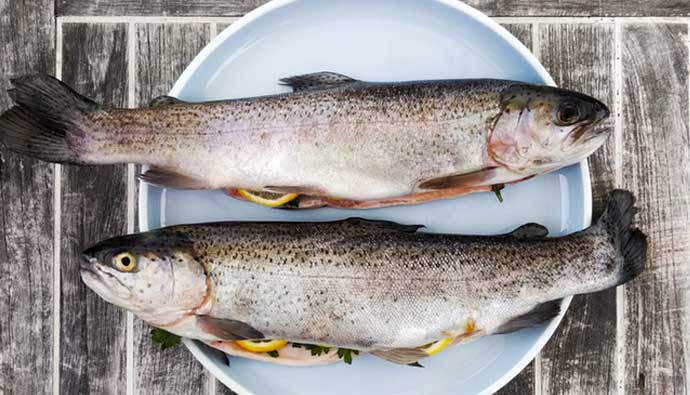
Trout is loaded with nutrients. Such as protein and vitamin D. Fish is also the world’s best source of omega-3 fatty acids, which are incredibly important for your body and brain.
Below is a recipe we at CAST & SPEAR think you will love. It is easy to prepare and very easy to enjoy!
Garlic Butter Trout: Total Prep Time 30 Min.
- 1 pound steelhead trout fillet, skin removed
- 2 tablespoons butter
- 1/2 a lemon, juice squeezed
- 1-2 cloves garlic, minced
- 1 teaspoon parsley, minced (optional)
- salt and pepper to taste
Preheat oven to 375° F.
Spray a sheet of aluminum foil with cooking spray and place the trout filet in the center. Fold up all 4 sides of the foil. Season trout with salt and pepper and then squeeze juice from half a lemon over the fish until covered.
Melt butter in a microwave-safe bowl, stir in fresh minced garlic, and drizzle over the trout until evenly coated. Top with fresh minced parsley.
Fold the sides of the foil over the trout, covering completely, and seal it into a closed packet. Place directly on oven rack and bake until cooked through, about 15-20 minutes.
Optional step: Open the foil exposing the top of the trout and broil for the last 4-5 minutes, for a browned top.
Insider Advice
Trout fishing is one of the more exciting and challenging forms of fishing. It has been common for many years for people to take a “trout fishing” trip.
This could be a company retreat, a couple of fishing buddies, or a complete family outing.
Whatever the reason for the fishing trip, it is sure to be one you will not forget.
Don’t forget to let us know if this guide helped you catch a trout. We love seeing your fishing pictures, so be sure to send us more 🙂




 Facebook
Facebook YouTube
YouTube
